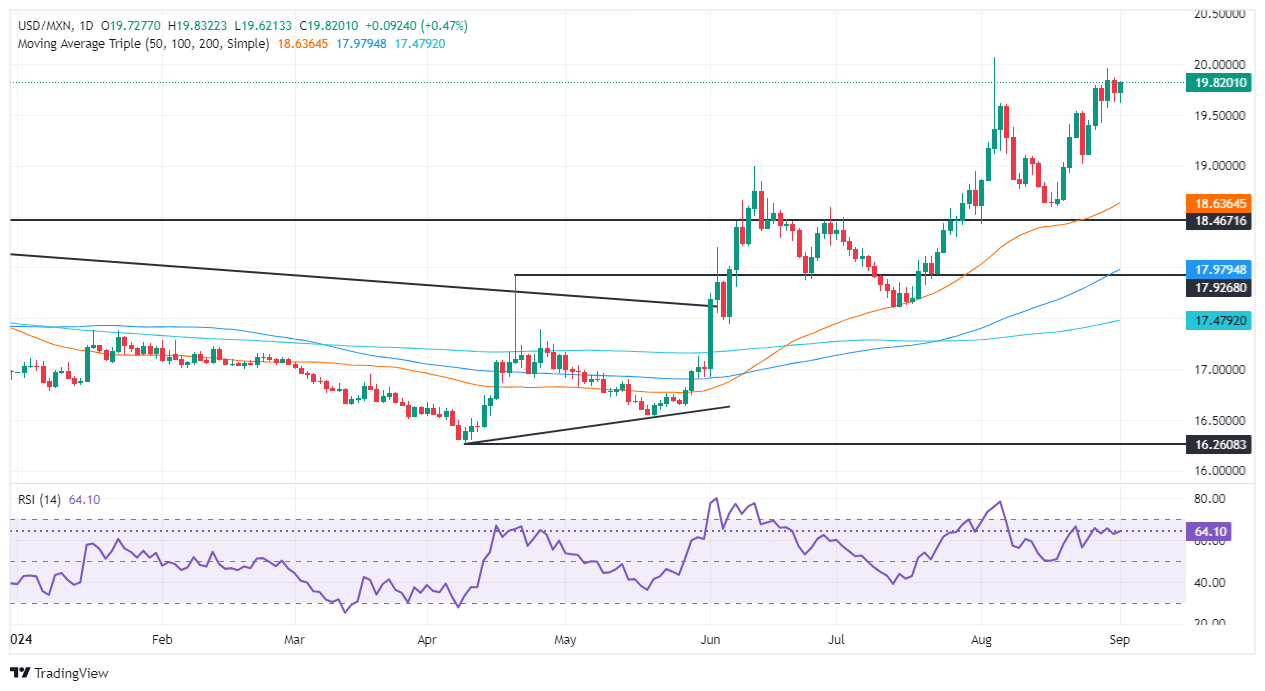- Mexican Peso weakens as USD/MXN climbs on judiciary reform concerns after new Congress convenes.
- Mexico's Business Confidence improves slightly in August, while Manufacturing PMI hits a two-year low, indicating sectoral challenges.
- S&P Global cites weak sales, competition from China, and highway insecurity as key issues for Mexican manufacturers.
The Mexican Peso begins September on a lower note, tumbling more than 0.50% amid renewed fears that the judiciary reform is a go and could be approved during the first week of the new Mexican Congress that took office on September 1. The USD/MXN trades at 19.80 after jumping from a daily low of 19.60.
Mexico’s economic docket featured Business Confidence in August, which improved slightly compared to July’s data. In the meantime, business activity in August, as measured by the S&P Global Manufacturing PMI, slumped to its lowest level in two years, the agency revealed.
At the same time, Mexican Business Confidence improved, driven by a minimal improvement in investment propensity, revealed the Instituto Nacional de Estadistica Geografia e Informatica (INEGI).
Recently, Banxico revealed its latest poll. Most analysts estimate a lower growth rate for 2024 and 2025, foreseeing the Gross Domestic Product (GDP) to hit 1.57% and 1.48%, respectively. Most analysts suggest the Mexican economy faces obstacles like “the lack of state of law,” which is one of the main drivers behind an investment decision.
Across the border, Wall Street remains closed due to the observance of the Labor Day holiday. Activities will resume on Tuesday, though traders are eyeing the release of employment data on Friday. Nonfarm Payrolls (NFP) for August are expected to exceed July’s data.
In the meantime, the latest inflation report by the US Bureau of Economic Analysis (BEA) revealed that the Core Personal Consumption Expenditures Price Index (Fed), the Fed’s preferred inflation gauge, remained unchanged at around 2.5% YoY.
Daily digest market movers: Mexican Peso on the defensive amid political turmoil
- Business Confidence improved from 53 to 53.2, expanding for the third straight month, yet it remains below the highest level reached in January of 54.4.
- S&P Global Manufacturing PMI contracted for the second consecutive month, from 49.6 to 48.5, hinting that Mexico’s economic slowdown is more profound than expected.
- Pollyanna De Lima, Economics Associate Director at S&P Global Market Intelligence, commented: “August proved to be another difficult month for Mexican manufacturers, with firms trimming output, employment, and stocks due to subdued sales in both the domestic and international markets. Total order book volumes dropped to the greatest extent in two years, boding ill for near-term production prospects.”
- De Lima added that companies became concerned about “intense competition from China and highway insecurity.”
- Most banks expect the Bank of Mexico (Banxico) to reduce rates by at least 50 basis points (bps) for the remainder of 2024. This would pressure the Mexican currency, which has already depreciated 15.38% year to date (YTD).
- Regarding this, a judge granted a stay over the weekend to prevent debate on the proposal. The initiative has sparked a strike in the judicial sector, strained relations with the United States, and shaken local markets amid widespread doubts it generates.
- US Nonfarm Payrolls in August are expected to grow from 114K to 163K, while the Unemployment Rate is foreseen ticking lower from 4.3% to 4.2%.
- Data from the Chicago Board of Trade (CBOT) suggests the Fed will cut at least 96.5 basis points (bps), according to the fed funds rate futures contract for December 2024.
Technical outlook: Mexican Peso weakens as USD/MXN climbs above 19.70
The USD/MXN uptrend remains in place, with the pair consolidating within the 19.50-20.00 range for the first trading day in September. Momentum shows further upside as the Relative Strength Index (RSI) is bullish and shifted flat from being tilted to the downside.
If USD/MXN buyers clear the 20.00 figure, there are plenty of additional topside targets. The next resistance would be the YTD high at 20.22, followed by the September 28, 2022, daily high at 20.57. If those two levels are surrendered, the next stop would be August 2, 2022, swing high at 20.82, ahead of 21.00.
On further USD/MXN weakness, the first support would be 19.50. A breach of the latter will expose the August 23 swing low of 19.02 before giving way for sellers eyeing a test of the 50-day Simple Moving Average (SMA) at 18.62.
Mexican Peso FAQs
The Mexican Peso (MXN) is the most traded currency among its Latin American peers. Its value is broadly determined by the performance of the Mexican economy, the country’s central bank’s policy, the amount of foreign investment in the country and even the levels of remittances sent by Mexicans who live abroad, particularly in the United States. Geopolitical trends can also move MXN: for example, the process of nearshoring – or the decision by some firms to relocate manufacturing capacity and supply chains closer to their home countries – is also seen as a catalyst for the Mexican currency as the country is considered a key manufacturing hub in the American continent. Another catalyst for MXN is Oil prices as Mexico is a key exporter of the commodity.
The main objective of Mexico’s central bank, also known as Banxico, is to maintain inflation at low and stable levels (at or close to its target of 3%, the midpoint in a tolerance band of between 2% and 4%). To this end, the bank sets an appropriate level of interest rates. When inflation is too high, Banxico will attempt to tame it by raising interest rates, making it more expensive for households and businesses to borrow money, thus cooling demand and the overall economy. Higher interest rates are generally positive for the Mexican Peso (MXN) as they lead to higher yields, making the country a more attractive place for investors. On the contrary, lower interest rates tend to weaken MXN.
Macroeconomic data releases are key to assess the state of the economy and can have an impact on the Mexican Peso (MXN) valuation. A strong Mexican economy, based on high economic growth, low unemployment and high confidence is good for MXN. Not only does it attract more foreign investment but it may encourage the Bank of Mexico (Banxico) to increase interest rates, particularly if this strength comes together with elevated inflation. However, if economic data is weak, MXN is likely to depreciate.
As an emerging-market currency, the Mexican Peso (MXN) tends to strive during risk-on periods, or when investors perceive that broader market risks are low and thus are eager to engage with investments that carry a higher risk. Conversely, MXN tends to weaken at times of market turbulence or economic uncertainty as investors tend to sell higher-risk assets and flee to the more-stable safe havens.
Information on these pages contains forward-looking statements that involve risks and uncertainties. Markets and instruments profiled on this page are for informational purposes only and should not in any way come across as a recommendation to buy or sell in these assets. You should do your own thorough research before making any investment decisions. FXStreet does not in any way guarantee that this information is free from mistakes, errors, or material misstatements. It also does not guarantee that this information is of a timely nature. Investing in Open Markets involves a great deal of risk, including the loss of all or a portion of your investment, as well as emotional distress. All risks, losses and costs associated with investing, including total loss of principal, are your responsibility. The views and opinions expressed in this article are those of the authors and do not necessarily reflect the official policy or position of FXStreet nor its advertisers. The author will not be held responsible for information that is found at the end of links posted on this page.
If not otherwise explicitly mentioned in the body of the article, at the time of writing, the author has no position in any stock mentioned in this article and no business relationship with any company mentioned. The author has not received compensation for writing this article, other than from FXStreet.
FXStreet and the author do not provide personalized recommendations. The author makes no representations as to the accuracy, completeness, or suitability of this information. FXStreet and the author will not be liable for any errors, omissions or any losses, injuries or damages arising from this information and its display or use. Errors and omissions excepted.
The author and FXStreet are not registered investment advisors and nothing in this article is intended to be investment advice.
Recommended content
Editors’ Picks

EUR/USD stays near 1.0500 after upbeat US data
EUR/USD continues to trade in a narrow range at around 1.0500 on Tuesday. The data from the US showed that job openings rose more than expected in October, helping the US Dollar hold its ground and limiting the pair's upside. Investors await comments from Fed officials.

GBP/USD trades below 1.2700 as focus shifts to Fedspeak
GBP/USD loses its recovery momentum and retreats to the 1.2650 area after rising toward 1.2700 earlier in the day. The US Dollar stays resilient against its rivals on upbeat JOLTS Job Openings data and makes it difficult for the pair to regain its traction as focus shifts to Fedspeak.

Gold keeps struggling for direction
Following Monday's retreat, Gold stabilizes and trades in a narrow band below $2,650. The benchmark 10-year US Treasury bond yield stays flat near 4.2% ahead of Fedspeak, making it difficult for XAU/USD to gather directional momentum.

Chainlink holds near three-year high fueled by EU tokenized securities partnership
Chainlink (LINK) price trades slightly down around $25.50 on Tuesday following a 33% rally that was spurred by its partnership with Frankfurt-based fintech 21X for Europe’s first tokenized securities trading and settlement system.

The fall of Barnier’s government would be bad news for the French economy
This French political stand-off is just one more negative for the euro. With the eurozone economy facing the threat of tariffs in 2025 and the region lacking any prospect of cohesive fiscal support, the potential fall of the French government merely adds to views that the ECB will have to do the heavy lifting in 2025.

Best Forex Brokers with Low Spreads
VERIFIED Low spreads are crucial for reducing trading costs. Explore top Forex brokers offering competitive spreads and high leverage. Compare options for EUR/USD, GBP/USD, USD/JPY, and Gold.
